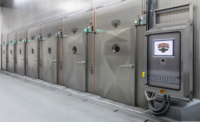Many meat processors have embraced the opportunity to maximize use of inputs and ensure the highest level of food safety during production by integrating critical software capabilities to leverage real-time actionable knowledge and provide insight and analytics for enhanced control, consistency and cost savings.
Stubbornly tight labor markets make the use of process controls and fully integrated operations management software systems increasingly necessary.
If a processor can automate a task and eliminate that workload from an employee to free that employee up to do something more productive, it doesn’t take long to pay for a lot of automation, Andrew Lorenz, CEO of We R Food Safety!, said during the 2022 Food Safety Report: Tips to Navigate the Challenges Ahead webinar.
Processors that have automated or those looking to do so are finding supply chain issues affecting availability of chips and other necessary tech components, Lorenz said.
“A lot of things that we can use to automate like remote probes and things of that nature – we can’t get the chips, we can’t get the boards, can’t get the antennas,” he said. “A lot of times we’re using wired technology versus wireless just because we can’t get the wireless antenna.”
He advised that processing operations should have a backup supply from a different vendor or a different model.
“When you’re looking to automate, make sure you have a supply chain,” he said. “I’ll say that 10 times. Make sure you’re supply chain is solid.”
Even more important than securing an operation’s supply chain is securing plant data.
The trend toward processors embracing integrated software systems and access to operation-wide shared data has led to issues with hacking, Lorenz said.
“We’re seeing an immediate split from that model,” he said.
More companies are now “stove-piping” data in the different production phases, requiring new ways of allowing access to data, he said.
“There’s ways to manage that risk by creating firewalls between different pieces of software, but it’s definitely a departure from where we were aiming to be even three years ago,” Lorenz said. “If you’re buying software systems, my advice is look at what they will work with, what they’ll integrate with and how flexible they are. And how secure they are”
“The day of total integration is gone,” he said.
Processors must resolve cybersecurity issues that can affect labor and hiring, such as whether to allow employees remote access to monitor operations, said Tom Egan vice president of Industry Services for PMMI, the Association for Packaging and Processing Technologies.
If a hacker wants to break in and steal your temperatures it’s not a big deal, but if they can break into a piece of software and get into your finance system and drain your bank that’s a whole other story, Lorenz said.

.png?height=96&t=1647275041&width=96)


Report Abusive Comment